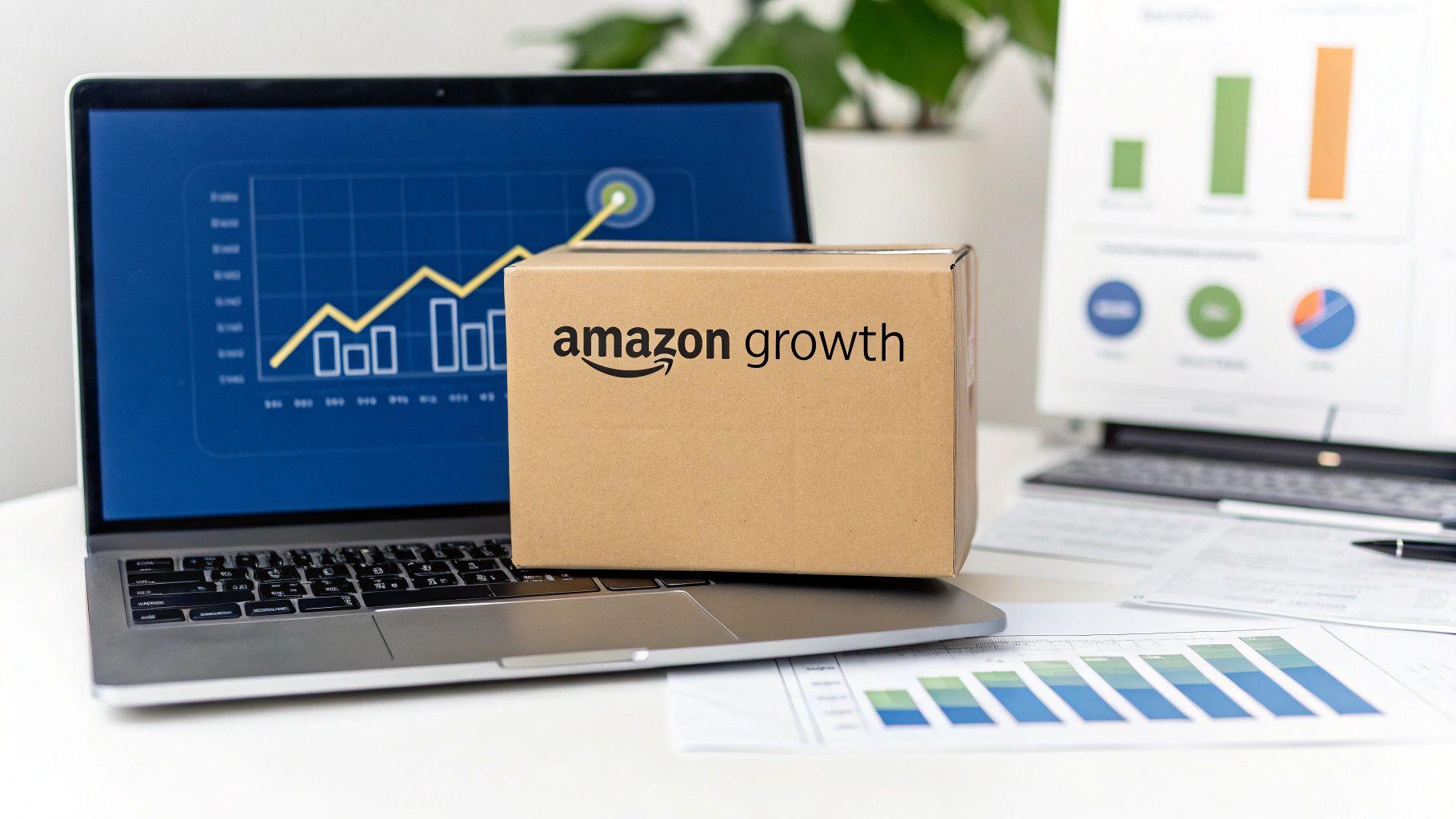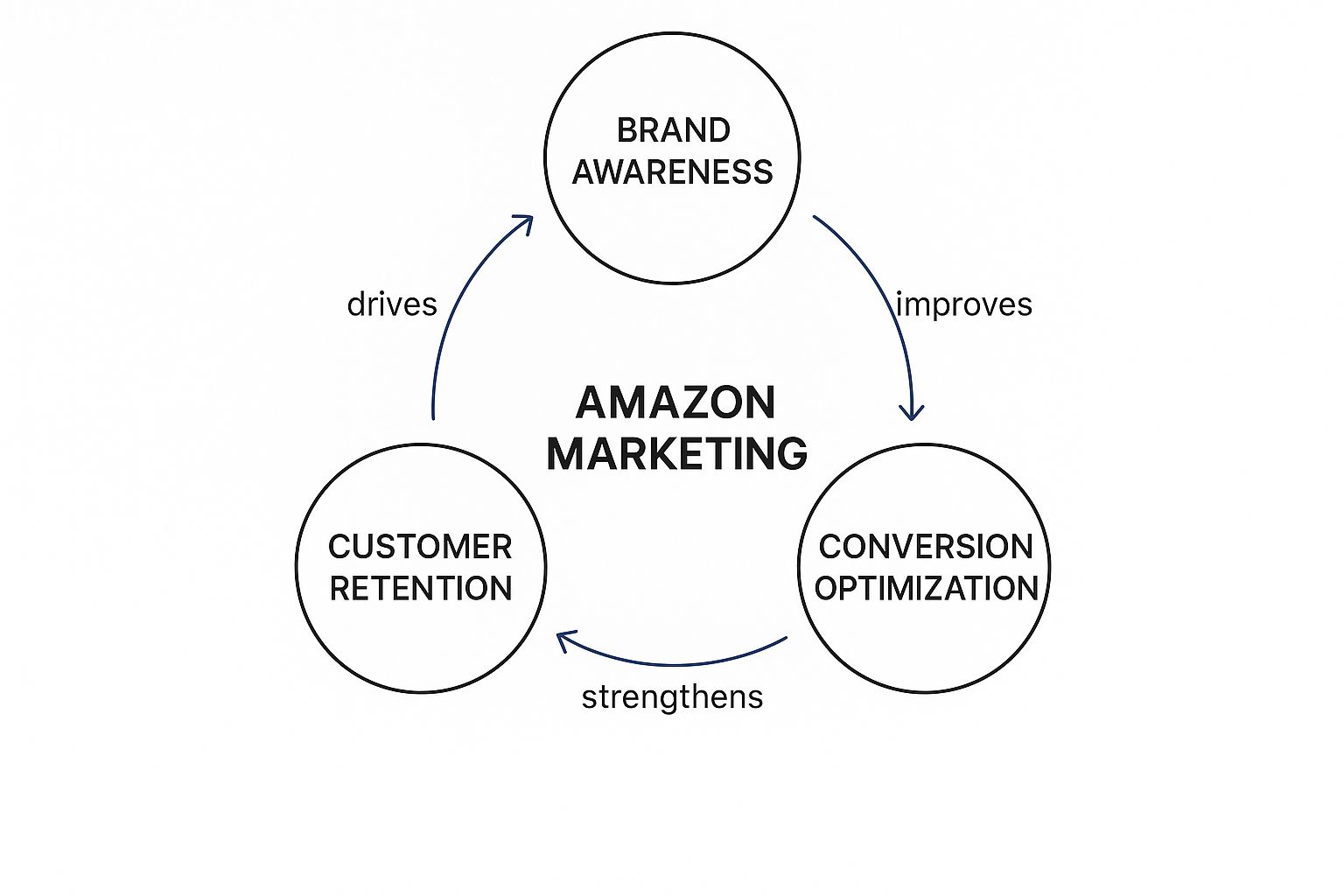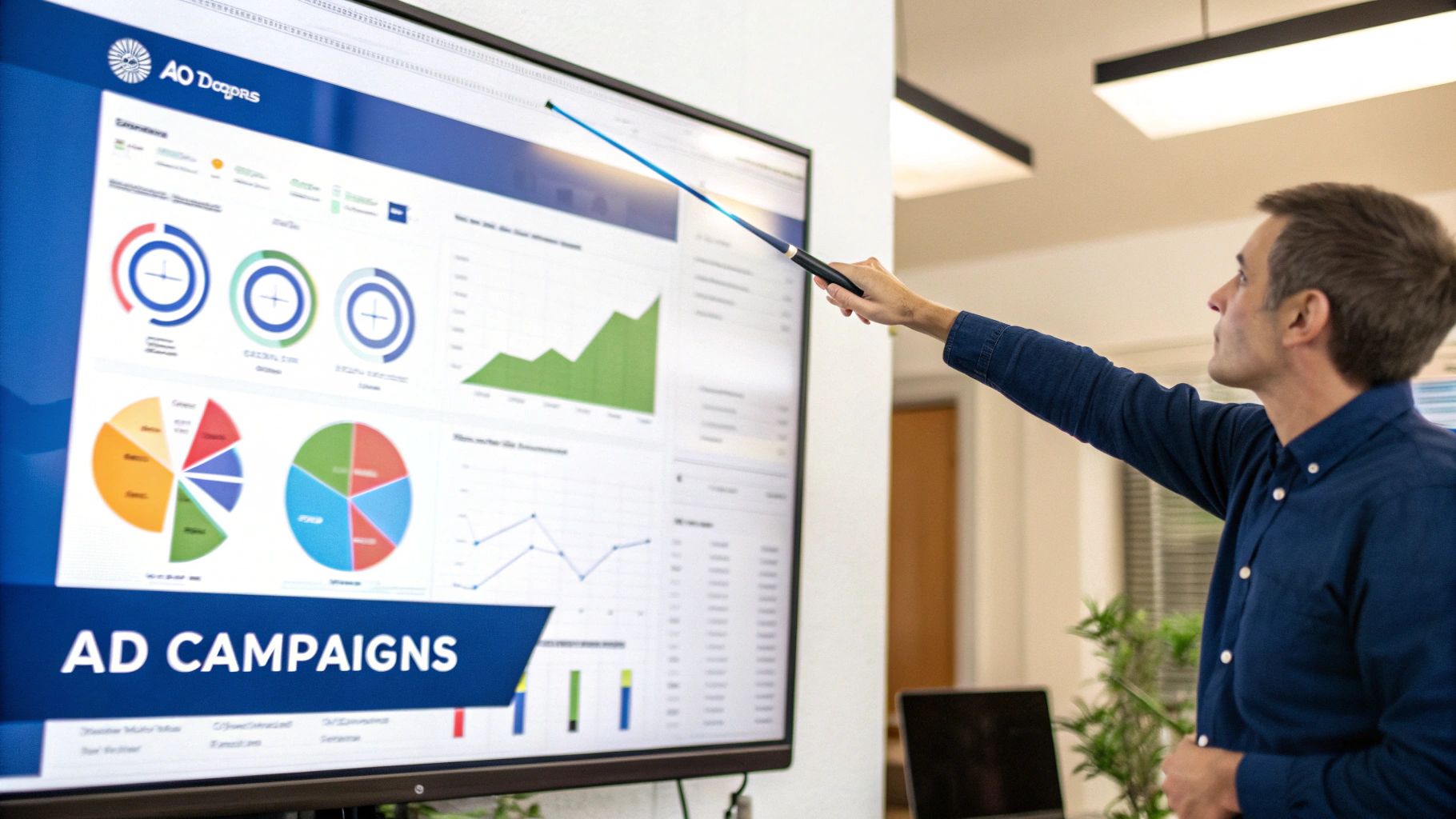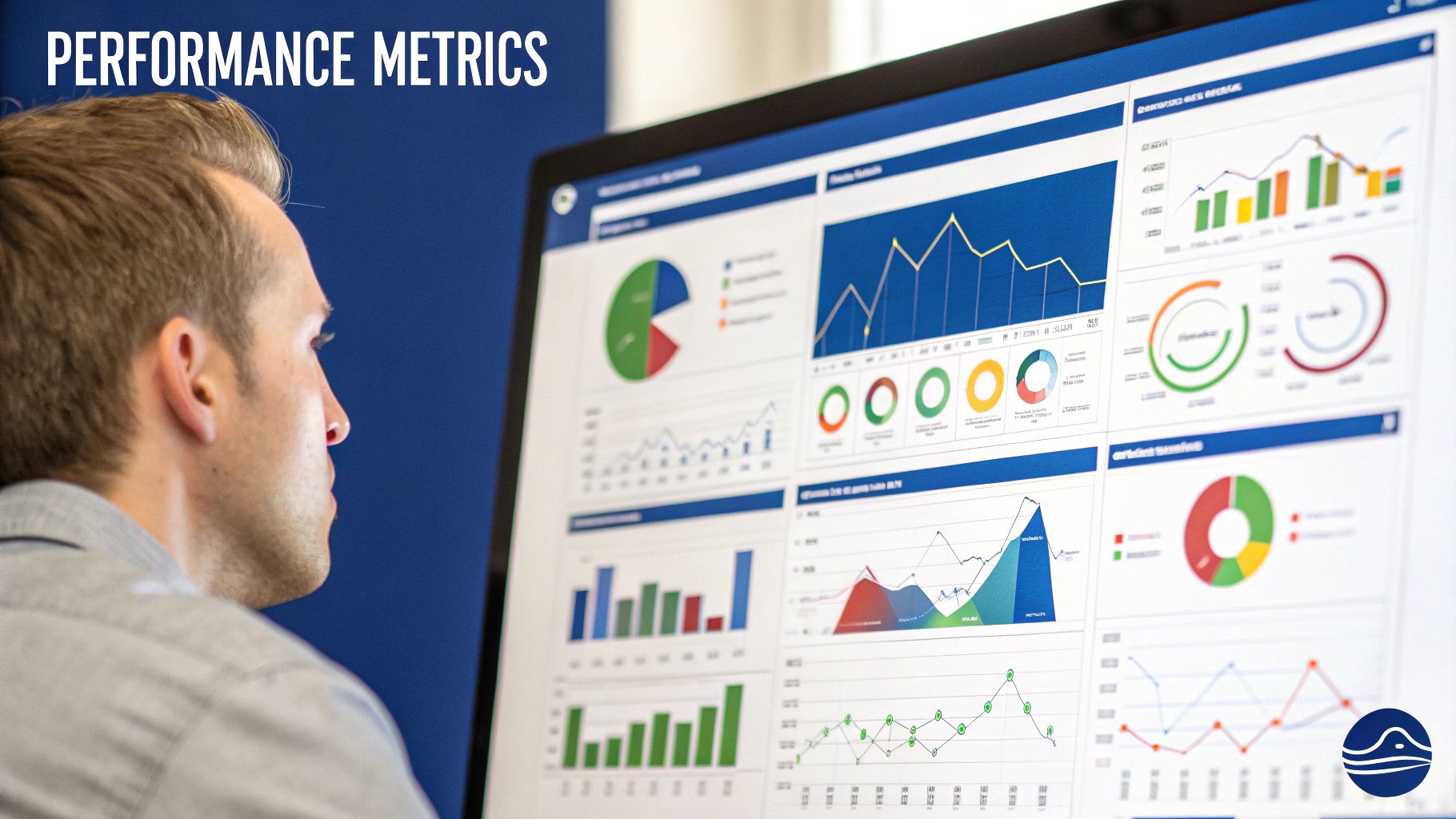Marketing Strategies on Amazon: The Performance-First Playbook for Scale
Explore top marketing strategies amazon to boost sales, enhance visibility, and grow your brand sustainably with proven tactics.

A winning marketing strategy for Amazon is no longer about throwing money at ads and hoping for the best. It’s about building a performance-driven growth engine. The most successful brands treat Amazon as a holistic ecosystem where paid advertising (PPC) is a direct lever for organic growth, profitability, and sustainable scale. This isn't about chasing vanity metrics; it's about building long-term enterprise value.
The Modern Playbook for Amazon Marketing
Too many brands operate in silos—PPC over here, SEO over there. That’s a critical, profit-killing mistake. The top 1% of sellers understand that these two channels are deeply intertwined, creating a powerful "flywheel effect." Strategic ad spend doesn't just generate immediate sales; it sends crucial positive signals to Amazon's A9 algorithm, which in turn boosts your product's organic ranking. It’s a powerful, self-reinforcing loop.
This performance-first mindset requires looking beyond basic metrics like Advertising Cost of Sale (ACoS). While ACoS offers a tactical glimpse, it fails to show how ad spend impacts total business health. Real growth comes from optimizing for total profitability and building a brand that dominates its category.
The Core Pillars of Amazon Growth
To build a resilient brand on Amazon, your strategy must balance three core activities in a continuous, data-driven cycle.
- Brand Awareness: This is top-of-funnel acquisition. You're introducing new-to-brand shoppers to your products using tools like Sponsored Brands and Amazon DSP. A key tactic here is leveraging the Amazon Influencer Program, which can drive a 5-10% lift in sales by placing products in front of established, trusted audiences.
- Conversion Optimization: You’ve captured their attention. Now your product detail page must convert. This is where you obsess over optimizing titles, imagery, A+ Content, and reviews to turn clicks into sales. With around 54% of product searches starting directly on Amazon, a highly optimized, conversion-focused page is non-negotiable.
- Customer Retention: The work isn’t finished at the first sale. Smart brands use retargeting ads and Subscribe & Save discounts to drive repeat purchases, which are significantly more profitable than constantly acquiring new customers.
This infographic illustrates how these three pillars create a virtuous marketing cycle.

As you can see, each stage flows into the next. A retained customer base drives positive reviews and sales velocity, which fuels new awareness and restarts the profitable cycle.
Headline’s Takeaway: Stop viewing your Amazon ad spend as a cost center. Every dollar is an investment in sales velocity, invaluable customer data, and a stronger organic rank. Adopting this performance-first mindset is the foundational step to building a truly dominant Amazon brand.
Building Your Foundation with Organic Ranking
It’s tempting to dive headfirst into paid advertising, assuming it's the fastest path to sales. This is a common and costly mistake. Before you invest a single dollar in PPC, you must build a rock-solid organic foundation.
Think of your product detail page as the foundation of a house. You wouldn't build on shaky ground. Getting your listing fully optimized for organic ranking is the bedrock of any profitable, long-term Amazon business.
This comes down to mastering Amazon’s A9 algorithm. A9 isn't just a search engine; it's a product-selling engine. Its sole purpose is to show customers the products they are most likely to buy. This means every element of your listing must appeal to two audiences simultaneously: the algorithm and the human shopper ready to click "Add to Cart."
Mastering Keyword Research for Conversion
Effective Amazon keyword research isn't about chasing the highest search volume. It's about identifying commercial intent. A high-volume keyword might drive clicks, but if it doesn't align with shopper intent, they’ll bounce immediately. This signals irrelevance to Amazon, causing your rank to plummet.
The objective is to find keywords that signal a strong intent to buy. These are often longer, more specific long-tail keywords. For example, a search for "running shoes" is exploratory. A search for "men's trail running shoes for wide feet size 11" is transactional.
Here’s how to find these high-intent terms:
- Analyze Your Competitors: Use tools like Helium 10 or Jungle Scout to see what keywords top competitors rank for. Don't just copy them; analyze why those keywords convert for that specific product.
- Mine Customer Reviews: Your own reviews—and your competitors'—are a goldmine of consumer language. You'll uncover the exact phrases real customers use to describe their problems and the features they value most.
- Leverage Amazon's Data: The "Search Query Performance" report in Brand Analytics is a powerhouse. It provides the exact terms shoppers use to find your products, complete with impression, click, and sales data for each one.
Crafting a High-Performance Product Detail Page
Once you have your high-intent keywords, strategically weave them into your product detail page. This is about creating a persuasive, natural experience for both the algorithm and the customer—not keyword stuffing.
Key Insight: Amazon's A9 algorithm is obsessed with two things: relevance and performance. It scans your listing text for relevance signals and then analyzes your sales and conversion rates to measure performance. A winning page nails both.
Your title is your most valuable SEO real estate. It must include your top 1-3 keywords while being readable and compelling. Your bullet points should be benefit-driven, answering customer questions and overcoming objections before they arise.
Finally, utilize your backend keywords. While invisible to shoppers, they are fully indexed by A9. This is the ideal place for synonyms, common misspellings, and related terms that don't fit naturally on the front end. To understand the mechanics in more detail, learn how the Amazon A9 algorithm works.
This holistic approach gives you the best possible chance to rank, turning your product page into a conversion machine before you ever launch a single ad.
Using PPC as a Lever for Organic Growth
Sponsored Products placements aren't just ads; they're your secret weapon for building organic momentum and gathering invaluable market data.
Too many brands view Amazon Pay-Per-Click (PPC) as a necessary evil—an expense that erodes margins. This is a fundamentally flawed perspective. For growth-focused brands, PPC is the single most powerful investment for fueling organic rankings and creating a self-sustaining sales engine. It’s not a cost center; it's a data-gathering, sales-velocity-building machine.
Think of your product listing as a high-performance race car. You've spent months optimizing it. Without fuel, it goes nowhere. PPC is the high-octane fuel that ignites the engine, driving the critical early sales that prove your product's relevance to the A9 algorithm.
The Flywheel: How PPC and SEO Feed Each Other
The link between paid ads and organic rank is direct and powerful. When you run a Sponsored Products campaign, you're paying to get in front of shoppers searching for your most important keywords. Every time a customer clicks your ad and buys, it sends an undeniable signal to Amazon.
That signal says, "When a customer searched for [your keyword], this product converted." Since Amazon's business model is built on customer satisfaction, your PPC campaigns provide the hard evidence A9 needs to boost your organic ranking for those same keywords.
This is indispensable for new products. Achieving organic visibility from a standstill is nearly impossible. PPC provides the initial sales history—a massive ranking factor—needed to get the flywheel spinning. If you're launching a new product, our guide on how to launch a product on Amazon details this entire process.
The Performance-First Takeaway: Your initial ad spend is an investment in two assets far more valuable than the sale itself: data and relevance. You learn which keywords actually convert, prove your product’s value to the algorithm, and build the sales history required to climb the organic ranks.
Structuring Campaigns for Actionable Data
A disorganized PPC account is a black hole for your budget. A well-structured account is a goldmine of actionable insights. The goal isn't just to generate sales; it's to understand exactly how you're generating them so you can scale what works.
Isolate variables by setting up your campaigns with a clean, logical structure.
Here’s a proven, effective structure:
- Automatic Campaigns: Use these as a discovery engine. Let Amazon find relevant keywords and ASINs. Your job is to meticulously analyze the search term reports, identifying high-converting "golden nugget" keywords you might have missed.
- Manual Keyword Campaigns: This is where you deploy your findings with surgical precision. Take the winning keywords from your auto campaigns and competitor research and create tightly-themed ad groups to test different match types (broad, phrase, exact) and optimize bids.
- Brand Defense Campaigns: This is non-negotiable. Run a campaign bidding on your own brand name to prevent competitors from siphoning off customers who are actively searching for you.
With over 60% of sales on Amazon coming from third-party sellers and nearly 9.7 million sellers on the platform, a data-driven ad strategy is the only way to ensure your marketing dollars build a sustainable, profitable business.
Advanced Amazon Advertising and DSP
Once your foundational PPC campaigns are driving consistent sales and organic lift, it's time to evolve from competing for sales to building a dominant brand. This means graduating to advanced strategies, primarily the Amazon Demand-Side Platform (DSP).
DSP represents a fundamental shift from reacting to customer searches to proactively creating demand.
Consider this analogy: Standard PPC is like having the best booth at a busy farmers' market; you capture customers who are already there to shop. DSP is like running a city-wide billboard and TV campaign; you reach people wherever they are—on other websites, in apps—and convince them to come to the market specifically to find you. This is how you transition from being just another product to a recognized brand.
When to Use DSP Instead of Standard PPC
This isn't an "either/or" decision. The most sophisticated brands integrate both Sponsored Ads (PPC) and DSP, as they serve distinct and complementary functions.
Here’s how to differentiate them:
- Sponsored Ads (PPC): This is your bottom-of-funnel conversion tool. It captures high-intent shoppers who are actively searching for products like yours right now. It is essential for driving immediate sales and defending your market share.
- Amazon DSP: This is your brand-building and demand-generation engine. Its purpose is to create future customers by reaching people who aren't yet in a buying mindset and guiding them through the consideration journey.
The Strategic Pivot: Use standard PPC to capture existing demand. Use DSP to go out and create new demand. A mature Amazon strategy masterfully blends both into a cohesive customer acquisition machine.
For instance, DSP is a powerhouse for retargeting. A shopper views your product and leaves? With DSP, you can serve them a reminder ad on a news site or weather app, gently pulling them back to complete the purchase. This level of audience-based targeting is something keyword-based PPC cannot achieve. Our comprehensive guide to DSP advertising on Amazon explores these capabilities in depth.
Building a Full-Funnel Advertising Machine
A true full-funnel strategy creates a predictable pipeline of new customers. DSP is built for this, allowing you to design campaigns that mirror the classic marketing funnel and guide shoppers from awareness to loyalty.
Instead of just bidding on keywords, you target audiences—groups of people defined by their shopping behaviors, demographic data, or past interactions with your brand.
- Top of Funnel (Awareness): Introduce your brand to new audiences. Target "in-market" audiences (people browsing your category) or "lifestyle" audiences (e.g., new parents, fitness enthusiasts). The goal is brand recall, not an immediate sale.
- Middle of Funnel (Consideration): Re-engage people who have shown interest. Retarget shoppers who viewed your product pages or even those who viewed your top competitors' pages, reinforcing your value proposition while they are still making a decision.
- Bottom of Funnel (Conversion): Close the deal. Target high-value audiences like cart abandoners. A well-timed ad served to this group can be incredibly effective at recovering otherwise lost sales.
This full-funnel system is amplified by Amazon's enormous user base, particularly its 240 million+ global Prime members. Events like Prime Day, which generated $14.2 billion in U.S. sales, demonstrate the immense power of this built-in audience. Effectively reaching these shoppers across their entire customer journey is the key to exponential growth.
Optimizing for Profitability and Sustainable Scale

Growth without profit is just a fast lane to burning cash. The brands that build real, lasting enterprise value are obsessed with sustainable, profitable scale.
This requires a strategic shift in how you measure success. It's time to move beyond the industry's narrow focus on Advertising Cost of Sale (ACoS).
ACoS measures campaign-level efficiency, but it provides a dangerously incomplete view of your business's health. A low ACoS might look good on a report, but it reveals nothing about your advertising's impact on total sales, organic rank, or brand equity. You can easily "win" on ACoS while your overall business stagnates.
Beyond ACoS: The Power of TACoS
To get a true picture of performance, you must track Total Advertising Cost of Sale (TACoS). This metric measures your total ad spend against your total revenue (paid + organic). It answers the single most important question: "Is my advertising investment making my entire business stronger?"
The formula is straightforward:
TACoS = (Total Ad Spend ÷ Total Sales) x 100
A decreasing TACoS over time is definitive proof that your advertising is fueling the organic flywheel. It shows your ad spend is building brand recognition and boosting organic rank, creating a healthier, less ad-dependent business. For any brand serious about long-term profitability, tracking TACoS is non-negotiable.
Holistic Amazon Performance Metrics
To truly understand profitability, you must focus on metrics that provide a complete business picture, not just isolated ad performance.
| Metric | What It Measures | Why It Matters for Profitability |
|---|---|---|
| ACoS | Ad Spend ÷ Ad Sales | A tactical metric for single-campaign efficiency. |
| TACoS | Total Ad Spend ÷ Total Sales | A strategic metric measuring advertising's impact on overall business growth. |
| Click-Through Rate (CTR) | Clicks ÷ Impressions | Measures ad creative and targeting effectiveness but doesn't guarantee sales. |
| Conversion Rate (CVR) | Orders ÷ Clicks | Measures how effectively your detail page converts traffic into sales. This is a core profitability lever. |
| Customer Lifetime Value (CLV) | Avg. Revenue per Customer | Predicts the total profit generated from a customer over their entire relationship with your brand. |
| Return on Ad Spend (ROAS) | Ad Revenue ÷ Ad Spend | Shows the direct return from ads but, like ACoS, misses the organic lift. |
Focusing on the right-hand column shifts your mindset from simply running ads to building a valuable, sustainable asset on the Amazon platform.
Driving Profitability Through Continuous Testing
Once you’re tracking the right metrics, you can systematically improve your bottom line. Profitability on Amazon is the result of continuous, data-backed optimizations. A rigorous A/B testing culture is your greatest competitive advantage.
Treat your marketing as a scientific process:
- Test Creatives: A/B test your main image. Does a lifestyle shot outperform a product-on-white photo? Test different video ad variations in Sponsored Brands campaigns to identify the highest click-through rate (CTR).
- Optimize Copy: A/B test product titles and the first three bullet points. Measure the impact on your conversion rate (CVR) when you lead with a different core benefit. Small copy changes can yield significant sales lifts.
- Refine Bids: Bidding is a dynamic process. If a keyword is driving clicks but no sales, lower the bid or pause it. If a keyword is a high-conversion machine, bid more aggressively to capture additional market share.
This disciplined approach ensures every marketing dollar is working as efficiently as possible to grow your business.
Aligning Marketing with Operations
Even the most brilliant marketing strategy can be completely undone by a stockout.
Running out of inventory is the fastest way to kill sales velocity and destroy the organic rank you fought so hard to earn. When a product goes out of stock, its listing effectively vanishes from search results. All the positive signals you sent to the A9 algorithm are erased overnight.
To prevent this, marketing and operations teams must be in lockstep.
- Forecast Demand: Use historical sales data and your promotional calendar to project future demand accurately, especially for peak seasons.
- Adjust Ad Spend: As inventory for a specific SKU runs low, strategically reduce ad spend and reallocate that budget to products with healthy stock levels.
- Communicate with Supply Chain: The marketing team must be aware of production lead times and potential shipping delays to build campaigns based on operational reality, not wishful thinking.
The Headline Takeaway: True, sustainable scale on Amazon is achieved at the intersection of profitability and operational excellence. Focus on strategic metrics like TACoS, commit to rigorous A/B testing, and align your advertising with your inventory. That is the formula for building a resilient, high-growth business.
Using Data and AI to Get Ahead
Winning on Amazon today is a game of data. The most effective marketing strategies are powered by artificial intelligence and machine learning. These are no longer just enterprise-level buzzwords; they are essential tools for optimizing listings, automating advertising, and outmaneuvering the competition.
Adopting AI isn’t about replacing your team; it's about giving them superpowers. AI acts as a tireless analyst, sifting through millions of data points to spot hidden patterns and execute tasks with a speed and precision no human can match. This is how you turn raw data into a decisive competitive advantage.
Getting in Sync with Amazon’s AI
You are playing in an AI-driven ecosystem. Amazon’s A9 search algorithm and its recommendation engine are sophisticated systems designed to maximize revenue by showing customers the products they are most likely to buy.
To succeed, your strategy must work with these systems by feeding the algorithm the high-quality, structured data it craves.
AI-driven tools can help you achieve this by:
- Optimizing Listings: AI can analyze top-performing competitor listings and thousands of customer reviews to identify high-converting keywords, craft benefit-driven copy, and recommend optimal A+ Content layouts.
- Finding Hidden Keywords: AI can analyze vast search datasets to automatically uncover long-tail keywords with high commercial intent and low competition.
- Smart Repricing: AI tools can monitor competitor pricing in real-time and dynamically adjust your prices to help you win the Buy Box without sacrificing profit margins.
This relentless focus on data-driven efficiency is how Amazon captured 38% of the U.S. eCommerce market. With 34% of sellers already using AI for listing optimizations, the shift to data-first selling is accelerating. You can read more about the trends shaping Amazon's marketplace.
Using Automation to Boost Performance
Beyond listing optimization, AI enables intelligent advertising automation. This is the leap from manual bid management to setting a high-level strategy and letting machine learning execute the day-to-day tactics.
Headline’s Takeaway: The purpose of AI in Amazon advertising is not to "set it and forget it." It’s to automate repetitive, low-value tasks, freeing up your team’s strategic brainpower to focus on high-impact activities like creative development, competitive strategy, and new product innovation.
AI-powered ad platforms can automatically shift budget away from underperforming keywords and toward high-converters. They can adjust bids based on placement performance and constantly test ad variations. You can even use external tools like an AI Pin Generator to supercharge Amazon sales to build new, data-informed traffic funnels from off-Amazon.
By leveraging these tools, your marketing transforms from a reactive, time-intensive chore into a proactive, profit-generating engine that scales with your business.
Frequently Asked Questions

We've covered the core strategies for a performance-first Amazon plan, but many leaders have practical questions about implementation. Let's address the most common ones.
How Much Should I Spend on Amazon Ads?
There is no magic number. The most common mistake is pegging your budget to a fixed percentage of revenue. Your ad spend should be a dynamic tool driven by your strategic goals.
When launching a new product, you should plan to spend aggressively. This is an investment in data and sales velocity to kickstart the organic ranking flywheel. For a mature product, the budget should be tied directly to profitability targets, measured by TACoS (Total Advertising Cost of Sale), not ACoS.
A better question is: "What is my acceptable customer acquisition cost, and what am I willing to invest to gain market share?" This reframes your budget as a flexible lever for growth.
How Long Until My PPC Efforts Boost Organic Rank?
While not instantaneous, the impact is often visible faster than you might think. For well-structured, conversion-focused PPC campaigns, you can typically see a measurable lift in organic rank for your targeted keywords within 2-4 weeks.
The key is generating sales through specific keywords. Every time a shopper searches a term, clicks your ad, and makes a purchase, it validates your product's relevance to the A9 algorithm. The more sales you drive for a given keyword, the faster your organic rank will climb.
Should I Drive External Traffic to My Amazon Listings?
Yes, but with extreme caution. Never send cold traffic directly from a social media ad to your product detail page. If this low-intent traffic fails to convert—and it likely will—it will damage your page's conversion rate. Amazon's algorithm will interpret this as a negative signal, which can harm your organic rank.
Headline’s Takeaway: If you drive off-Amazon traffic, send it to your Amazon Storefront or a custom landing page first. This acts as a filter, warming up the audience so that only the most interested, high-intent shoppers reach your product detail page. This crucial step protects your conversion rate and overall listing health.
Effective marketing strategies for Amazon are built on a disciplined, data-driven, and performance-first mindset. It's about ensuring every dollar spent drives immediate sales while simultaneously building a stronger, more profitable brand for the future.
At Headline Marketing Agency, we don't just manage ad spend; we turn it into real enterprise value. We build comprehensive Amazon strategies that focus on profitability and organic growth, moving you beyond vanity metrics to achieve real business results. Discover how we build dominant Amazon brands.
Ready to Transform Your Amazon PPC Performance?
Get a comprehensive audit of your Amazon PPC campaigns and discover untapped growth opportunities.